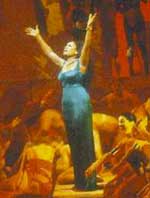
It took just one newspaper story about the Metropolitan’s imminent Samson et Dalila production to heat up opera chat in cyberspace, where there was much huffing and puffing in advance about the Met’s latest wallow in Eurotrash. Well, so much for prejudgments – “À moi! Philistins! à moi!” as Dalila calls out at the end of Act Two. The new Samson turns out to be a bold, theatrically compelling piece of work, in a class with the company’s recent stagings of Tchaikovsky’s Eugene Onegin and Britten’s A Midsummer Night’s Dream – but then, a lot of people hated those provocative productions as well.
Of course, there has always been a suspicion in some quarters that Saint-Saëns’s popular score is more oratorio than opera. I disagree, and apparently so do Elijah Moshinsky, who directed, and Richard Hudson, who designed the sets and costumes. In fact, the production faithfully reflects the singular structure of the work itself, an opera erected on a sequence of great musical blocks as muscular as Samson himself and as imposing as the temple pillars the blinded hero pulls down. The tone is set by the drop curtain – a palimpsest of Hebrew and Aramaic lettering savagely disfigured by a gigantic black smear – and the hot, angry colors of Hudson’s painterly sets continue to develop variations on that theme of culture clash and the doomed love affair arising from it. It may be that the fiercely vivid African motifs resemble what one sees in The Lion King, also designed by Hudson, but any accusations of a made-to-order look-alike won’t wash, since the Met’s Samson was in the planning stage long before that Broadway hit opened.
Ever since his underappreciated debut back in 1980 directing Verdi’s Un Ballo in Maschera, Moshinsky seems to have been trying to please the Met more than himself, with such wishy-washy efforts as Ariadne and Otello. Perhaps that will change now that the company has begun to welcome a diversity of production styles and is prepared to stand by the results. In any case, Moshinsky has been sufficiently emboldened to come up with his most original work to date, an approach that has the courage to present the opera as Saint-Saëns wrote it, a cleverly manipulated lyrical ritual constantly in danger of fracture and destruction. Even the chorus has been sensitively grouped to generate maximum theatrical tension – the choreographic assassination of Abimelech in Act One is especially effective – and the heat is sustained right up to the final cataclysmic curtain.
The purely musical report is less happy. The temple luckily collapses before Plácido Domingo’s climactic B flat threatens to do the same, and elsewhere the tenor’s increasingly unavailable high notes continue to be a problem. Apart from that, Domingo’s Samson is reliably sung, although he might work a bit harder to project some of the great hero’s dilemma in the face of Denyce Graves’s sultry but strangely generic Dalila. Graves underplays the Philistine temptress, making her motives fascinatingly ambiguous, but she sings with such a paucity of vocal nuance and technical savvy that Dalila’s dangerous personality fails to register. The only other role of consequence in the opera is the evil High Priest of Dagon. Sergei Leiferkus looks horrifying in his startling white makeup, but his scratchy baritone still sounds dreadfully inelegant in French opera. Leonard Slatkin conducts efficiently, pacing the extended musical periods with care for their architectural shape but with little appreciation for the score’s instrumental color and drama.